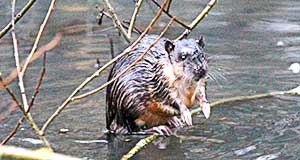Australian Placental Animals Native & Introduced Placental Mammals in Australia
Placental mammals develop their offspring inside their body in a uterus to which is attached an organ called a placenta (hence the name placental). They give birth to babies that are far more advanced in their development than marsupial and monotreme mammals.
Because of Australia's isolation, there are few native placental mammals. The first of these to arrive in Australia were bats and rodents that flew or floated across the oceans to Australia from neighbouring islands between 5-15 million years ago. Marine mammals such as the Dugong and Australian seal also swam their way to Australia sometime in the very distant past. The next to arrive were the Aborigines who came to Australia around 50,000 years ago (yes humans are placental mammals too). Ancient seafarers from Asia introduced the dingo about 5,000 years ago. It was only with the arrival of European settlers in 1778 that a substantial number of other placental mammals such as cattle and sheep were introduced to Australia.
Dingo
Dingoes are wild dogs brought to Australia by humans 5,000 years ago. There is controversy as to whether they are native or introduced animals.
Read MoreCamel
Dromedary camels and Bactrian camels were used for transporting in the harsh Australian outback. A camel gives birth to a single calf.
Read MoreRabbit
20 rabbits were brought to Australia in 1859. Today there are over 10 billion rabbits. They are the most destructive of introduced animals..
Read MoreHorse (Brumby)
Brumbies are wild horses. They are descendants of animals that escaped from early European settlers. They destroy native habitat.
Read MoreCat (Feral)
Feral cats are domestic cats that have gone wild and kill native animals. There were no cats in Australia prior to European settlement in 1788.
Read MoreFlying Fox (Bat)
Flying Foxes also known as fruit bats are relatively large flying herbivorous mammals. They rely on their sight rather than echolocation.
Read MoreBuffalo
Water buffaloes were introduced to supply meat for settlers. They can grow up to 2m in height, 3m in length and weigh up to 1,200 kgs.
Read MoreRed Fox
The red fox was imported in the 1850s. Today it is found in over 75% of Australia and is an invasive pest. There are 7.5 million foxes in Australia today
Read MoreDugong
Dugongs are plant-eating marine mammals. Because of their sleek, smooth appearance ancient sailors thought they were mermaids.
Read MoreHouse Mouse
The house mouse is one of the few animals that wasn't brought to Australia intentionally. It hitched a free ride on ships.
Read MoreGoat
Goats escaped into the wild and now cause significant damage to the environment by overgrazing and depriving other animals of food.
Rakali (Water Rat)
The Rakali is a semi-aquatic native placental mammal. It lives in burrows on the banks of rivers. It eats insects, fish, crustaceans, snails, and frogs.
Rat
Black and brown rats arrived on board the first European ships to come Australia . They carry diseases and eat farm crops.
Pig (Feral)
Feral Pigs are the descendants of pigs brought to Australia by European settlers. Many were allowed to roam and soon became wild.
Sea Lion
Australian sea lions stocky bodies, a large head, and short narrow flippers. The male is twice as large as the female. They hunt fish and squid.
Whale
Humpback whales travel up from the Antarctic to give birth and feed their young. They can grow to 12 – 16 metres and weight 36,000 kgs.
Benteng
The Banteng was introduced by the British army in 1849 at a remote outpost in Northern Australia which was later abandoned.
Characteristics of Placental Mammals What Makes Placental Mammals Different

Photo: Rakali Water Rat - Native Placental Mammal
Photo: Diagram of human placenta
Birth
The key characteristic of a placental mammal is that it gives birth to babies that are far more advanced in their development than monotremes and marsupials. They do this by developing their offspring inside their bodies in a uterus. The baby is attached to the uterus by an organ called a placenta which in turn is connected to the mother's blood supply. In this way, the baby gets all the nutrients it needs to grow. The term "placental" is somewhat misleading because marsupial mammals also have a rudimentary placenta. The key difference is that in a placental mammal the baby remains attached to the placenta inside the mother's uterus for a relatively longer period of time compared to a marsupial. Placental mammals are sometimes called eutherian mammals to try to clear up this confusion. Because they have a uterus, placental mammals do not have a pouch.
Lactation
Placental mammals provide nourishment for their young by providing them with milk through a teat or nipple. Because the baby is already relatively well developed before it is born the period of lactation is much shorter than for equivalent marsupials.
Photo: Cow - An introduced placental mammal
Body Temperature
In general placental mammals have a body temperature of 38°C. This is about 3°C higher than most marsupial.
Metabolism
The basal metabolic rates (BMRs) of placental mammals is about 30% higher than marsupials.
Other
In general placental mammals have less teeth than marsupials. They also grow two pairs of teeth, namely milk teeth and adult teeth.
Learn More About Australia's Incredibly Quirky Animal
All Rights Reserved. (Last Updated: Aug 31, 2021)